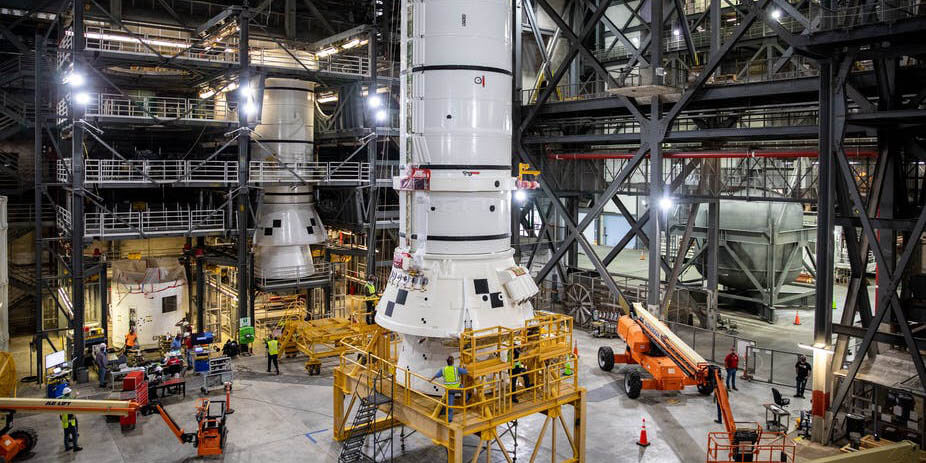
By Monica Grady, The Open University. This article is republished from The Conversation under a Creative Commons license.
Astronomers ended 2021 on a high with the launch on December 25 of the James Webb Space Telescope, a joint mission between the European Space Agency, Nasa and the Canadian Space Agency. It was a relief to hear that the precision drives that opened up the complex sunshield, which is about the size of a tennis court, worked perfectly.
The telescope is now on the way to its destination, 1.5 million kilometres away from Earth, where it will begin a series of tests once it arrives in late January. If the mission goes to plan, we can expect to start receiving images from the telescope in mid-2022.
But what else lies in store for space science this year? Here are a few missions to watch out for.
Nasa’s Artemis programme to send human astronauts back to the Moon in 2024 should get underway in 2022. The last astronauts to step foot on the Moon in 1972 made it there on a Saturn V rocket. Now Nasa has created a new generation of rockets, the Space Launch System (SLS), which will be tested for the first time in March with the launch of the Artemis 1 mission. This will be a three-week-long, uncrewed test flight of the Orion spacecraft, which will include a flyby 100km above the surface of the Moon.
Eventually, the SLS will transport astronauts to the Lunar Gateway, the next-generation international space station that will be positioned in orbit around the Moon and act as a way station for missions to the surface.
The Moon will also be targeted by other space agencies in 2022. South Korea is hoping to launch its first lunar mission, the Korea Pathfinder Lunar Orbiter, from Cape Canaveral in August. Roscosmos, the Russian space agency, plans to launch Luna 25 to the Moon’s south pole in July – over 45 years since Luna 24 returned almost 200g of lunar soil in August 1976.
Mid 2022 will be a busy time for space exploration, as Nasa will also launch its Psyche asteroid mission. Psyche, which is orbiting the Sun between Mars and Jupiter, is an M-class asteroid, made of metal, so it’s similar to the core of the Earth.
We’ve never been close to an M-class asteroid before, nor have we been able to study the core of the Earth because it’s too deep down, so once this mission arrives in 2026 it should give us a whole new understanding of asteroid and planetary processes.
The Near-Earth Object Hazard Information Profile

Hazard Type: EXTRATERRESTRIAL
Hazard Cluster: Extraterrestrial
Specific Hazard: Near-Earth Object
Definition:
A near-Earth object (NEO) is an asteroid or comet whose trajectory brings it to within 1.3 astronomical units of the Sun and hence within 0.3 astronomical units, or approximately 45 million kilometres, of the Earth’s orbit
See the full list of Hazard Information Profiles here.
Not long after Psyche’s journey begins, the Dart mission, which launched in November 2021, should arrive at its destination in late September.
Dart – which stands for the double asteroid redirection test – is heading to asteroid Didymos and its moonlet Dimorphos. The goal is to test what technology it would take to save the Earth from an incoming asteroid in future. Dart will deliberately crash into the smaller of the two bodies, Dimorphos, to move its orbit a little bit closer to Didymos, the larger one. This could give valuable insights into how to shift any asteroid on a collision course with Earth in the future.
2021 was a busy year for Mars missions with the launch of Nasa’s Perseverance rover and the Chinese Zhurong rover, both of which continue to send back incredible images and data from the surface of the red planet.
In September 2022, the European Space Agency is due to launch the next part of its ExoMars mission in collaboration with Roscosmos. The first part of the mission, ExoMars 2016, sent a Trace Gas Orbiter to orbit around Mars in late 2016.
ExoMars 2022 plans to send a Mars rover, the Rosalind Franklin, to the Martian surface to look for signs of past life. If the launch goes to plan, we’ll have to wait until 2023 for ExoMars to arrive and for the rover to start roaming the surface.
All in all, 2022 is looking to be a very exciting and fruitful time for space exploration.
Monica Grady, Professor of Planetary and Space Sciences, The Open University
This article is republished from The Conversation under a Creative Commons license. Read the original article.
Image: The rocket boosters for the Space Launch System that will launch Nasa’s Artemis I mission to the Moon. NASA/Kim Shiflett